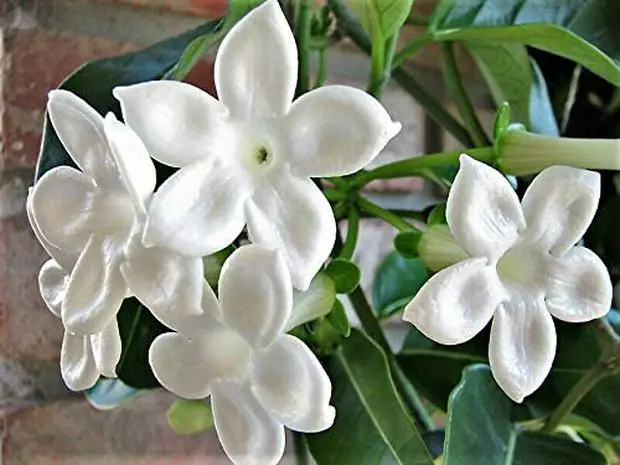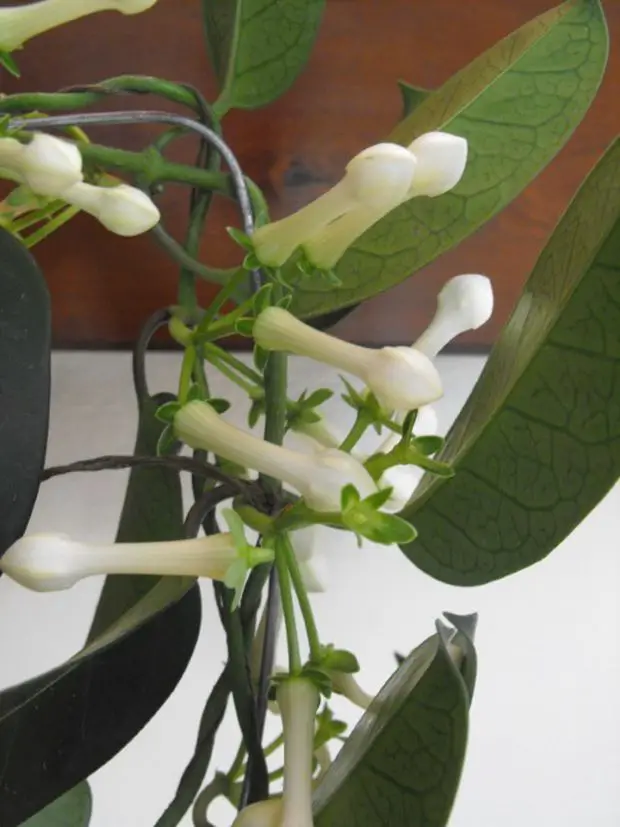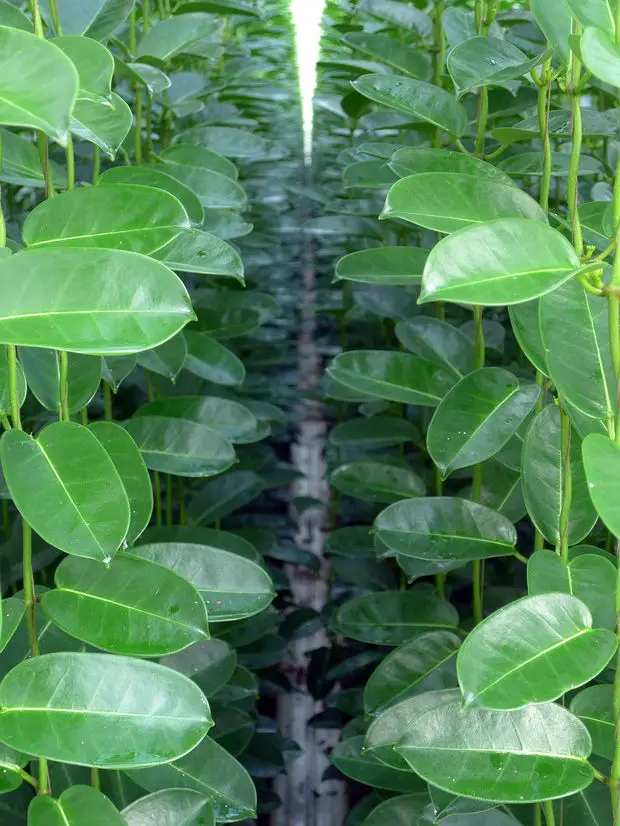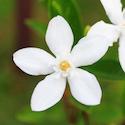Madagascar jasmine (Stephanotis floribunda) is a ravishing and everlasting tropical species native to Madagascar. This jasmine plant is grown easily in sub-tropical and tropical regions where the climate mainly consists of hot and humid monsoon and cooler periods. These aesthetic plants usually fully bloom in spring, summer and autumn where they showcase their waxy and star-shaped flowers. The foliage of Madagascar jasmine makes this vine well worth growing to decorate your favorite places.

When it comes to indoors cultivation, Madagascar jasmine can be quite challenging to get to bloom its flowers, because it is somewhat difficult to reproduce the outdoors growing conditions where this plant best thrives in the wild, inside. We explain what you can do about it!
Madagascar jasmine is known for incredibly fragrant flowers. Each star-trumpet-shaped flower tends to grow in clusters on vines in thick, oval, forest green leaves. Due to their waxy texture, Madagascan jasmines’ flowers scent lasts a long time, with an intense, rich and sweet aroma.
Common causes for a lack of flowers
There are a couple of things you can cause the lack of flowers. Odds are, your Madagascar jasmine suffers from one or more of them, if you notice that flowers fail to bloom.
Issues with the soil
The roots might be too compacted in soggy soil, therefore unable to absorb and soak on the necessary nutrients to blossom the flowers. The Madagascan jasmine must have a very well-drained soil for it to flower.
Pruning can help
You didn’t prune your plant after flowering in the previous cycle or you did it too late in the year. It is crucial that you properly prune your Madagascan jasmine plant after flowering, no later than mid-summer, in order to guarantee more and bigger blossoms in the next season.
Also, because these plants can die without giving too much notice, you will need to be quick in the propagation process, this is especially important for indoors Stephanotis plants. Usually, the propagation starts by taking some tip cuttings from the non-flowering lateral area of the plant of about 8 cm long every spring or summer. You will then need to submerge those cut ends in what is called ‘hormone rooting powder’. These products can be commercially bought or if you are a keen gardener like I am, you can make it yourself with one of my all natural formulas. Either use:
- Saliva! Yep! Your own saliva, as it is a natural anti-bacterial or anti-fungal substance that will prevent the roots from rotting and will promote the root growth. Make sure you've not eaten for a while before using this root grower. Or, go for:
- Apple cider or vinegar diluted in water. 5 drops per 10 fl. ounces (about 300ml) of water works a treat too. Maybe experiment with both formulas and see what works better in your hands.
After dipping those cut ends in either of those agents, plant each cutting in a small pot where you will add equal parts of peat moss, coarse sand and some perlite. Next, protect the plant from not reaching more than the appropriate temperature, by enclosing the potted plant in a breathable plastic bag (poke small holes) and keep it at about 65° F (or 18 °C) in bright light without direct sunlight at first. Water it enough to keep it moist and humid and soon you will have a fully ready plant for moving to a soil-based pot for more established plants.
Too much water
You might be over-watering your Madagascar jasmine. Keeping the roots too moist is problematic and could in extremes even rot them during the resting period. Excessive moisture renders the plant unable to absorb appropriate amounts of nutrients. You should keep your Stephanotis plant at the size and height of your desire, as long you are able to care for it with manageable water levels in the resting period, until the next season.
Location, location, location
Your Madagascan jasmine plant could not be getting enough light or not enough shade. Your plant needs a minimum of 4-6 hours of direct sunlight to be able to flower. And it is as crucial (especially if you are living in a subtropical or tropical region), to ensure that your Stephanotis gets enough shade after the time of direct sunlight to rest and avoid a heatwave stress. If this happens too much, your plant might die altogether.

Air moisture
Your Madagascan jasmine could be exposed to too much dry air. Dry air conditions affect the blooming potential negatively. Most of the jasmine species are native and adapted to semi-tropical regions and because of that, they love humid air. You might have to increase the humidity in the environment of your plant to mimic the conditions in the wild. If you have an indoors plant, a possible fix is to place some gravel or small rocks (ideally use a porous material, like basalt or perlite) in the tray where your pot is resting on and fill it up until half way with water but be cautious not to overload it and drown your plant. As the water evaporates, it will increase the humidity around the plant. Porous rocks are preferred, because they bind more water and release it more slowly. If your plant is outdoors, the same trick works as well. Put the porous pebbles on top of the soil and then keep them wet by watering them with a hose.
A mostly Stable Temperature
Your Madagascan jasmine might have been exposed to too many drastic temperature changes. When these plants are exposed to rapid temperature changes, they have been known to drop their flower buds suddenly before they have started flowering and they also could be responding by turning their leaves yellow. Madagascar jasmines are warm-climate vines and grow at their most when the temperature remains above 50 °F (10 °C) in the winter, but also not much higher than 80 °F (26 °C) in the summer. For example, if you have an indoors Stephanotis and you would like to move it outside, you first need to make sure that the temperature is similar indoors and outdoors. Conversely, when transferring your Madagascar jasmine from a hot outdoors location to an air-conditioned cooled room, you might experience that your plant won’t bloom.
Fertilizer
A lack of flowers on your Madagascan jasmine could also indicate, that fertilization is either lacking or done with the wrong kind of fertilizer. Fertilizers that contain too much nitrogen cause a lot of plant growth to go towards foliage and will take it away from the blooms that are forming in the buds. Consider switching to a fertilizer with a low, or even no-nitrogen product. Higher content in Phosphorus might be all that is needed to boost your Madagascar jasmine into full bloom mode.
There have been numerous times where I have gone crazy with the thought "my Madagascan jasmine won’t flower" until I finally realized that getting the appropriate type of fertilizers for my Stephanotis was crucial. The same could be true for you.

Fertilizer Requirements
If your established Madagascar jasmine plant is not looking vibrant in some stages, you should keep in mind that there are soil tests available to identify if there is a nutrient that might be lacking. Doing these tests allow you to optimize your fertilizer. Depending on the developmental state of your Madagascar jasmine Plant, the fertilizer requirements will be slightly different:
Juvenile plants
Young plants will need plant foods with higher contents in phosphorus. That will boost the root development and is crucial to establish your plant. Search for fertilizers with phosphorus as a main component (you can identify these if phosphorus is mentioned first or second in the label list of ingredients). Then, apply the right amount recommended by the producer, especially during the first growing season.
Entrenched plants
Older, more established plants, will need fertilizers that have higher amounts of Nitrogen to promote the green foliage growth. As stated above though, an excess of nitrogen in the soil will cause excessive leave growth in your Stephanotis plant sacrificing flower bud development so make sure you avoid fertilizing late in the growing season to prevent this situation.
Indoor vs. Outdoor
Indoors Madagascan jasmine plants are a totally different story, as they are harder to keep alive and get to blossom. Ideal fertilizers will be water-soluble and quick release as a general concept. They should be used every two weeks (or as per label instructions). It should be a slow and temperature controlled release where they will usually be used only once during the growing season. Organic plant foods in this case are an optimal choice of care, such as bone meal, fish emulsions or ‘Nutrient Rich Rock Phosphate Natural Source of Phosphate and Seeds’. This last one is definitely my favorite as it is a rich, slow and long term phosphorus release fertilizer, which is definitely what you are after to get a full bloom of those gorgeous flowers you seek. They will be used late in October and then resumed back in February to help kicking off the flowering process.
Conclusion
To conclude, the Madagascar jasmine or Stephanotis floribunda is a delicate and sensitive plant to care for and to experience the full beauty of its flowers as both fertilization and your hands on techniques as well as environmental conditions (temperature and humidity) have to be optimal.
But if you keep in mind all those reasons described above, as to why your Madagascan plant won’t grow beautiful flowers, and optimize the growing conditions for them one by one, you will most likely be blessed with the most exquisite scented flowers out there, which by th way are a symbol of marital happiness in some cultures. Simply avoid frosts, try to grow them against a sunny wall where they can benefit from reflective heat, prune them a little every season after flowering to ensure next year’s blossoms can start on new growth!. Propagate them, get the right fertilizers and keep them humid at all times.
Thanks for reading and good luck with your Madagascan jasmines.
